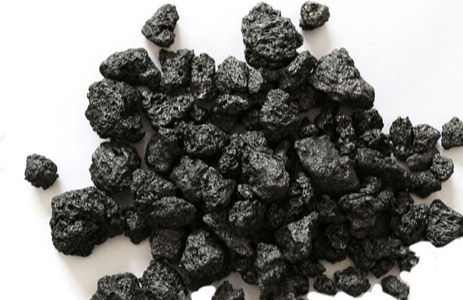
Petcoke (also known as coke fuel) is produced by the thermal breakdown of crude oils. It has a black metallic luster, is hard, dense, and porous. By weight it contains up to 97% carbon as well as other metals, hydrogen, nitrogen, and sulfur. Because of its low volatility and high carbon content, it is an efficient fuel. However its high sulfur and lack of ash can cause problems in terms both technical and environmental.
Calcined Petroleum Coke (CPC), a form of electrically inconducive carbon, is used to produce graphite electrodes that are suitable for use in electric arc furnaces at aluminum smelters. This is created by heating or calucining green petrol coke (GPC), in either a rotary or spiral kiln.
Calculation not only decreases the residual volatile matter, but it also makes the GPC more ordered and electrically conducive. These qualities can be useful in forming pitch-bonded oels for aluminum production. The material is used to produce refractory products such as bricks and foundry items, along with high-purity, pure carbon.
In a vessel that is closed, the calcination takes place. The hot coke can then be cooled with water. Natural draft air is used to complete the cooling process. This causes coke particles to crumble, tumble and tumble again. The final calcined petrol coke produced is then crushed and sized to suit its intended use.
There are two main methods of producing CPC: delayed coking and fluid coking. This method of delayed coking can be found in refineries which process heavy crude oil. This involves several coking chambers that can take hours to finish.

If you use a delayed coking technique, your final coke will be either of fuel or anode grades. Fuel grade coal has a greater VM, making it less useful for anode production. Anode grade coke, on the other hand, has a much lower VM content and is required for anode production. The independent or merchant GPC calciners usually blend GPC's with different GPC quality to produce the anode coke required by smelters.
It is true that the CPC production process can be complex. But there are several ways you can improve productivity and efficiency at a smelter. The energy content of the feedstock coke, the operating parameters at the smelter and the improvement in metallurgical techniques are all important.
In order to maintain a consistent supply of a quality CPC, it is important that all parties involved in the production process understand what goes into making this critical carbon product. Testing and characterization of raw materials can have a major impact on the process. Test results on petcoke are useful in ensuring proper calcination, and optimizing all associated processes. It will result in a more stable smelter operation, improved product quality and lower cost for consumers and producers.

Write a Message